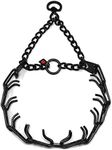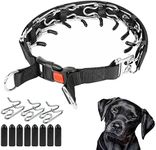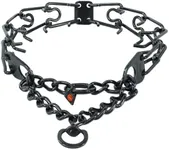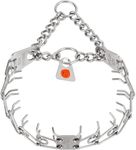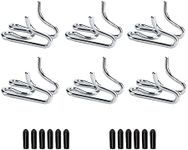Buying Guide for the Best Prong Collars
Choosing the right prong collar for your dog is an important decision that should be made with care and understanding. Prong collars are training tools designed to help manage strong or reactive dogs, but they must be used responsibly and with proper knowledge. The key to picking the best prong collar is to focus on your dog's size, temperament, and training needs, as well as your own experience and comfort with using such tools. Always remember that prong collars are not a substitute for positive training and should be used as a temporary aid under guidance if possible.Prong Size and ThicknessProng size refers to the thickness and length of the individual metal links that make up the collar. This is important because the size of the prongs affects how the collar distributes pressure around your dog's neck. Thinner prongs create a sharper sensation, while thicker prongs are milder. For small or sensitive dogs, thinner prongs may be too harsh, so thicker prongs are better. For larger, strong-willed dogs, slightly thinner prongs may be more effective, but always ensure they are not too sharp. Choose a prong size that matches your dog's neck size and sensitivity, and always start with the gentlest option that is effective.
Collar Length and AdjustabilityCollar length determines how well the prong collar fits your dog's neck. A proper fit is crucial for safety and effectiveness. The collar should sit high on your dog's neck, just behind the ears, and be snug but not tight. Most prong collars are adjustable by adding or removing links. When choosing, make sure the collar can be adjusted to fit your dog's neck comfortably. If your dog is still growing, consider a collar that allows for easy adjustment as your dog changes size.
Material QualityThe material of the prong collar affects its durability, comfort, and safety. Most prong collars are made from stainless steel, chrome-plated steel, or other metals. Stainless steel is rust-resistant and strong, making it a good choice for dogs that swim or live in humid areas. Cheaper metals may rust or break more easily. Some collars have rubber tips on the prongs for added comfort. Choose a collar made from high-quality, rust-resistant material to ensure it lasts and remains safe for your dog.
Closure MechanismThe closure mechanism is how the collar opens and closes around your dog's neck. Some prong collars have a quick-release buckle, while others require you to separate the links. Quick-release buckles are easier and faster to use, especially if you need to remove the collar quickly. If you are new to prong collars or want extra safety, a quick-release option may be best. If you are comfortable handling the links, a traditional design may suffice.
Safety FeaturesSafety features can include things like a backup loop or secondary attachment point, which prevents the collar from coming off if a link fails. Some collars also have rounded or rubber-tipped prongs to reduce the risk of injury. When choosing a prong collar, look for features that enhance safety, especially if your dog is strong or reactive. Always supervise your dog when using a prong collar and never leave it on when unsupervised.


